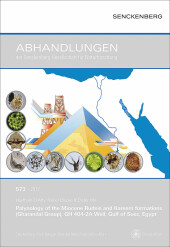 Neuerscheinungen 2017Stand: 2020-02-01 |
Schnellsuche
ISBN/Stichwort/Autor
|
Herderstraße 10
10625 Berlin
Tel.: 030 315 714 16
Fax 030 315 714 14
info@buchspektrum.de |

Rainer Brocke, Haytham El Atfy, Dieter Uhl
(Beteiligte)
Palynology of the Miocene Rudeis and Kareem formations (Gharandal Group), GH 404-2A Well, Gulf of Suez, Egypt
2017. 134 S. 5 Abb., 1 Tabellen, 24 SW-Taf. 300 mm
Verlag/Jahr: SCHWEIZERBART´SCHE VERLAGSBUCHHANDLUNG 2017
ISBN: 3-510-61408-9 (3510614089)
Neue ISBN: 978-3-510-61408-0 (9783510614080)
Preis und Lieferzeit: Bitte klicken
The Gulf of Suez is the main oil province in Egypt, with oil being produced from Paleozoic, Mesozoic and Cenozoic rocks. The Miocene sediments are the most prolific hydrocarbon-bearing sequences both in onshore and offshore fields. Major research activities have been so far concentrated on structural geology, geophysics, organic geochemistry, stratigraphy, and mlcropaleontology. in contrast, very little has been published on the Miocene palynology from this region. A comprehensive palynologlcal investigation on the GH 404-2A Well (southern part of the Gulf of Suez), comprising the Miocene Rudeis and Kareem formations of the Gharandal Group has produced diverse palynomorph assemblages They contain dinocysts, spores, pollen, algae, fungal palynomorphs, scolecodonts and microforaminiferal linings. For the first time in Egypt, the present study introduces a detailed systematic overview of the palynomorphs with respect to their biostratigraphy and paleoenvironment within this time interval. Biostratigraphically, three dinocyst and one sporomorph biozones are established and correlated with other Miocene schemes from Egypt and other areas worldwide. In addition, the palynomorphs are used to get further insights both into the adjacent land vegetation and climate of the Gulf of Suez area, during the Miocene, and relate these paleoenvironmental conditions to depositional processes in the Gulf of Suez basin.


